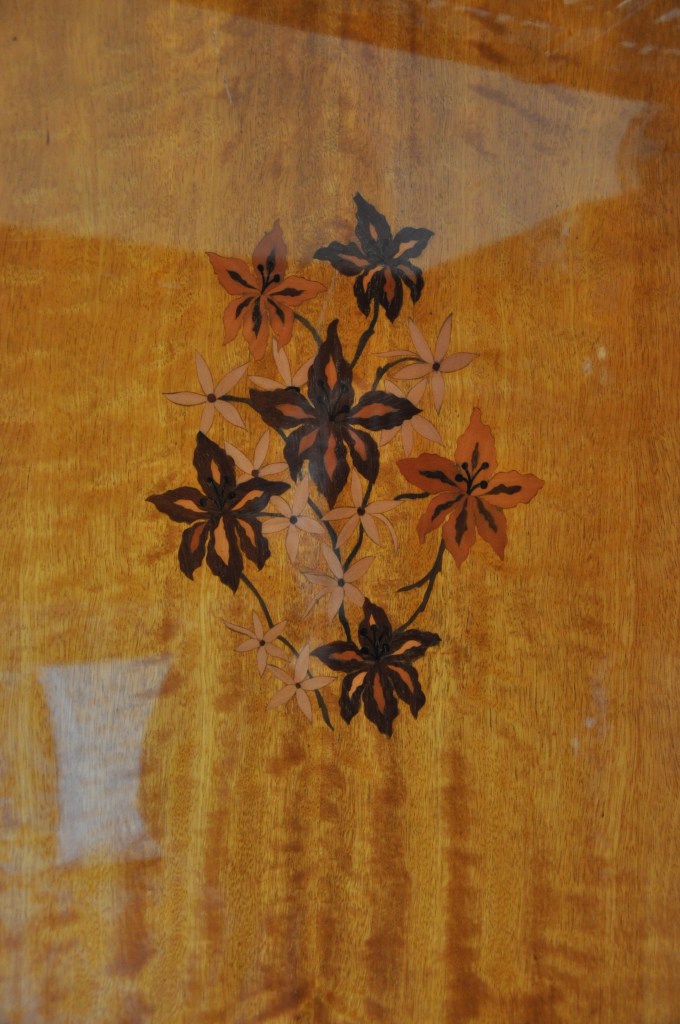- Therefore Another Prologue: Orient Express, Day 1
- Only Success and New Learning: Orient Express, Day 2
- An American Artist in London: Orient Express, Day 3
- It’s Not NOT True…: Orient Express, Day 4
- All Aboard!: Orient Express, Day 5, part a
- All Aboard! Orient Express, Day 5, part b
- All Aboard!: Orient Express, Day 5 & 6, (part C)
- Verily, Venice: Orient Express, Days 7-12
- Venice-Simplon Orient Express: thoughts
Imagine for a moment that you are stepping off a bus into an ordinary car park. Then, as you walk between a couple of delivery vans you see it: the Belmond Venice Simplon-Orient-Express train, with a line of staff waiting to greet you in front of the carriages in their distinctive navy blue and cream.

The train is eighteen carriages long and made up of two cars with “Grand Suites,” ten cars with sleeping carriages for guests, two for staff accommodations, three dining cars, and the “bar car.” We were in one of three “Tiger Lily” themed sleeping carriages, all built in 1929, designated Carriage D, Cabin 1.

Our Steward, Helene, met us at the carriage entrance and explained that our luggage would be delivered momentarily. She then went over the details of our cabin, gave us a key and explained to us how to lock and unlock our cabin. By then, our luggage having arrived, she bade us a warm welcome and left to assist the next guests. Inside the cabin was a charming packet of VSOE stationary, a note of welcome from the Train Manager, a small bottle of prosecco, still and sparkling mineral water, a map of the train journey, and a charmingly illustrated booklet about the train.

The cabins are small enough that you may want to take turns dressing for dinner. (I looked it up and a standard double cabin is 1903 mm x 1478 mm which is about 6.2 ft by 4.8 ft.) Each has different upholstery, but the overall layouts are very similar: the main seating area has a comfortable banquette, small folding table, a stool with fabric cushion, and a lamp. Your storage is in a narrow rack above the window and a wide upper luggage rack along the wall across from the sofa, There are a couple of hooks above the sofa. Each cabin has a small radiator, a window which can be lowered from the top, a small fan, reading lights for each bunk, and two 220-volt European style 2-pin sockets.
In the corner is the wash basin, an ingenious closet containing a sink with hot and cold water taps, a mirror, glasses, more bottled water, several hand towels, a razor power socket, and a collection of toiletries created by Temple Spa. There were also two sets of kimono-style robes and terrycloth slippers.

Some of you may have noticed two (big) gaps in our description of the cabin, and it’s true: there are no toilets or showers in these cabins. There is a single toilet stall at the end of the carriage (opposite to ours, we had to walk the length every time we used the facilities). To be fair, it’s kept immaculately clean and was rarely occupied. Everyone has to do without a sluice until they arrive in their Venice accommodations. (There is also no air conditioning, but that is less urgent when you can roll down a window and get fresh air.) Nonetheless, the cabin was incredibly comfortable as we left Calais and began to wend our way through France towards Paris and beyond.
One of the things Helene explained to us is that we needed to choose one of two seating’s for dinner and that the Maître d’hôtel would be coming by after departure to inquire. The choices were 18:45 and 9:30 and we could specify any preferences (such as sitting with or near others, or which dining car you want). There are three restaurant cars, each with distinctive decor: The Cote d’Azur (built in 1929) has lovely Lalique glass panels showing classical figures holding grapes and upholstered in a medium blue pattern with gray curtains. The Etoile du Nord (built in 1926) features beautiful marquetry and is dark green upholstery and gray curtains. L’Orientale (built in 1927) features Chinese-style lacquer wall panels with upholstery in gold and cream curtains. We had no preference and were seated in the Cote d’Azur, which turned out to be our favorite.




Soon after departure, we made our way to the bar car, #3674. Here we enjoyed a glass of champagne, the music from the pianist, and the company of other train goers.
The dress code aboard the VSOE, as their materials state, is “There is no such thing as over-dressed!” No where is that more evident than at dinner. Formal is the way to go, with a small amount of leeway given for being aboard a train. This is not the time for the 5″ Jimmy Choo heels, nor that gown that involves hoops or crinoline. There were a lot of sequins, satin, jewels, and the length was calf or heel. Men were in dark suits or tuxedos. It was very elegant.
We shimmied into our formal wear, both in navy blue, took a few pictures, then made our stately way to our dining car.




